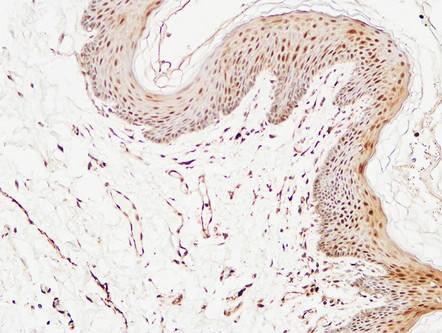Thioredoxin Polyclonal Antibody
- Catalog No.:YT6065
- Applications:WB;IHC;IF;ELISA
- Reactivity:Human;Mouse;Rat
- Target:
- Thioredoxin
- Fields:
- >>NOD-like receptor signaling pathway;>>Parkinson disease;>>Salmonella infection;>>Fluid shear stress and atherosclerosis
- Gene Name:
- TXN TRDX TRX TRX1
- Protein Name:
- Thioredoxin
- Human Gene Id:
- 7295
- Human Swiss Prot No:
- P10599
- Mouse Gene Id:
- 22166
- Mouse Swiss Prot No:
- P10639
- Immunogen:
- Synthesized peptide derived from human Thioredoxin. at AA range: 52-101
- Specificity:
- This antibody detects endogenous levels of Thioredoxin
- Formulation:
- Liquid in PBS containing 50% glycerol, 0.5% BSA and 0.02% sodium azide.
- Source:
- Polyclonal, Rabbit,IgG
- Dilution:
- IHC: 100-300.WB 1:500-2000, ELISA 1:10000-20000. IF 1:50-200
- Purification:
- The antibody was affinity-purified from rabbit antiserum by affinity-chromatography using epitope-specific immunogen.
- Concentration:
- 1 mg/ml
- Storage Stability:
- -15°C to -25°C/1 year(Do not lower than -25°C)
- Other Name:
- Thioredoxin (Trx;ATL-derived factor;ADF;Surface-associated sulphydryl protein;SASP)
- Observed Band(KD):
- 12kD
- Background:
- The protein encoded by this gene acts as a homodimer and is involved in many redox reactions. The encoded protein is active in the reversible S-nitrosylation of cysteines in certain proteins, which is part of the response to intracellular nitric oxide. This protein is found in the cytoplasm. Two transcript variants encoding different isoforms have been found for this gene. [provided by RefSeq, Oct 2011],
- Function:
- function:ADF augments the expression of the interleukin-2 receptor TAC (IL2R/P55).,function:Participates in various redox reactions through the reversible oxidation of its active center dithiol to a disulfide and catalyzes dithiol-disulfide exchange reactions. Plays a role in the reversible S-nitrosylation of cysteine residues in target proteins, and thereby contributes to the response to intracellular nitric oxide. Nitrosylates the active site Cys of CASP3 in response to nitric oxide (NO), and thereby inhibits caspase-3 activity.,PTM:In the fully reduced protein, both Cys-69 and Cys-73 are nitrosylated in response to nitric oxide (NO). When two disulfide bonds are present in the protein, only Cys-73 is nitrosylated. Cys-73 can serve as donor for nitrosylation of target proteins.,similarity:Belongs to the thioredoxin family.,similarity:Contains 1 thioredoxin domain.,subunit:Homodimer; di
- Subcellular Location:
- Nucleus . Cytoplasm . Secreted . Translocates from the cytoplasm into the nucleus after phorbol 12-myristate 13-acetate induction (PMA) (PubMed:9108029). Predominantly in the cytoplasm in non irradiated cells (PubMed:11118054). Radiation induces translocation of TRX from the cytoplasm to the nucleus (PubMed:11118054). Secreted by a leaderless secretory pathway (PubMed:1332947). .
- Expression:
- Brain,Cajal-Retzius cell,Cerebellum,Cervix,Epithelium,Fetal brain cortex,Hepatocyte,Lens,Ma
Sinensetin, a polymethoxyflavone from citrus fruits, ameliorates LPS-induced acute lung injury by suppressing Txnip/NLRP3/Caspase-1/GSDMD signaling-mediated inflammatory responses and pyroptosis Food & Function Zaibin Xu WB Mouse lung tissue RAW264.7 cell
- June 19-2018
- WESTERN IMMUNOBLOTTING PROTOCOL
- June 19-2018
- IMMUNOHISTOCHEMISTRY-PARAFFIN PROTOCOL
- June 19-2018
- IMMUNOFLUORESCENCE PROTOCOL
- September 08-2020
- FLOW-CYTOMEYRT-PROTOCOL
- May 20-2022
- Cell-Based ELISA│解您多样本WB检测之困扰
- July 13-2018
- CELL-BASED-ELISA-PROTOCOL-FOR-ACETYL-PROTEIN
- July 13-2018
- CELL-BASED-ELISA-PROTOCOL-FOR-PHOSPHO-PROTEIN
- July 13-2018
- Antibody-FAQs
- Products Images

- Western Blot analysis of 1,mouse-liver 2,hela cells using primary antibody diluted at 1:1000(4°C overnight). Secondary antibody:Goat Anti-rabbit IgG IRDye 800( diluted at 1:5000, 25°C, 1 hour)

- Immunohistochemical analysis of paraffin-embedded Human skin. 1, Antibody was diluted at 1:400(4° overnight). 2, High-pressure and temperature EDTA, pH8.0 was used for antigen retrieval. 3,Secondary antibody was diluted at 1:200(room temperature, 30min).

- Immunohistochemical analysis of paraffin-embedded Human skin. 1, Antibody was diluted at 1:400(4° overnight). 2, High-pressure and temperature EDTA, pH8.0 was used for antigen retrieval. 3,Secondary antibody was diluted at 1:200(room temperature, 30min).


